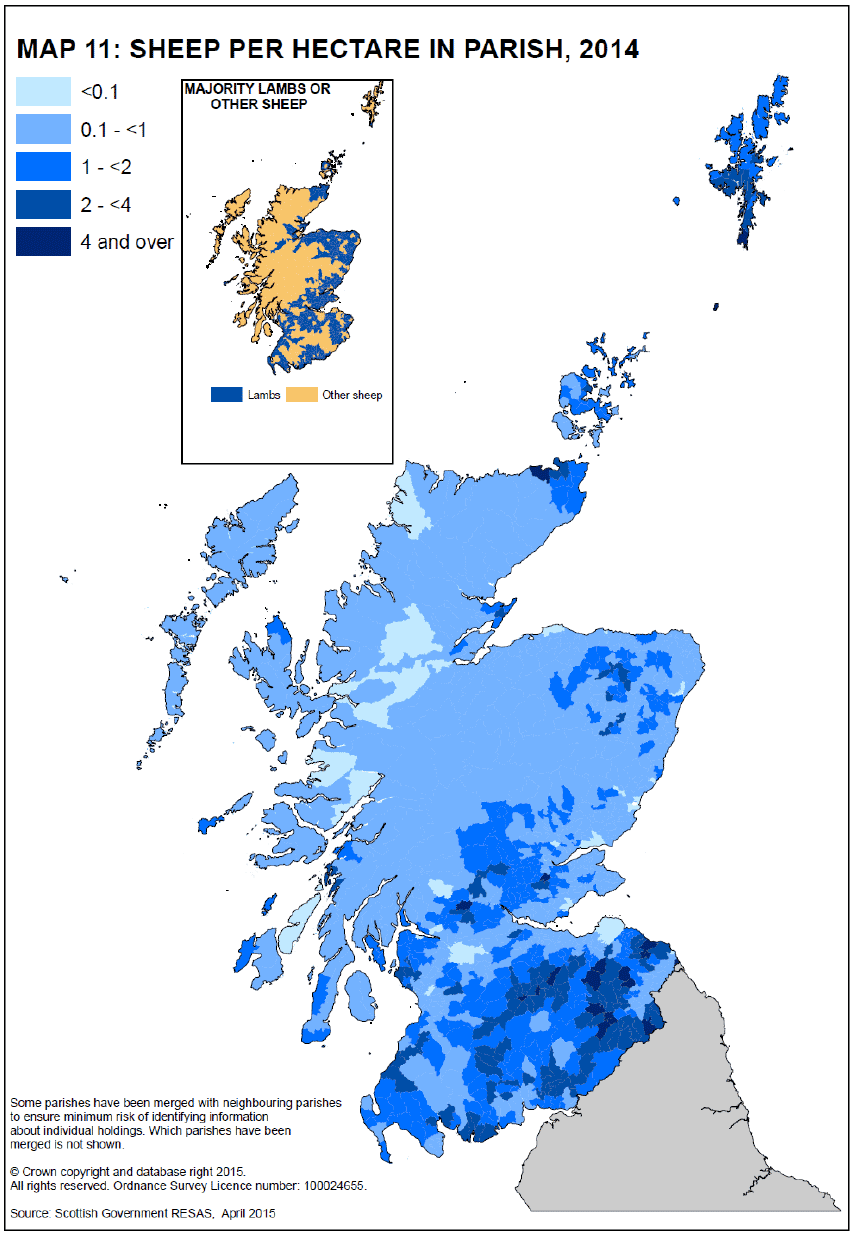Economic Report on Scottish Agriculture 2015
Economic Report on Scottish Agriculture 2015 presenting an overall picture of Scottish agriculture using data from the various agricultural surveys that RESAS manage.
5.3 Sheep
The number of sheep in Scotland has gone through a series of fluctuations in the past 125 years, with peaks in the thirties, the sixties and the nineties. Numbers have been just below seven million for the last five years, levels last seen in the 1940s.
Chart 5.13: Number of sheep in Scotland, 1883-2014
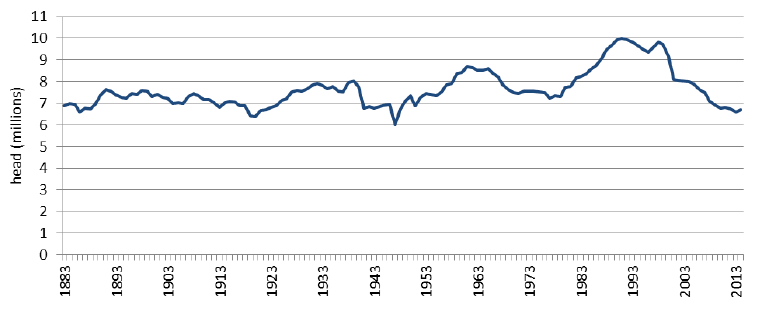
5.3.1 Distribution of sheep (Table C10(i), C10(ii))
There were 6.69 million sheep in Scotland in June 2014. Areas with the highest numbers of sheep were the Scottish Borders (1.15 million or 17 per cent of the total), Dumfries and Galloway (1.02 million or 15 per cent), the Highlands (866,000 or 13 per cent), Grampian (621,000 or nine per cent) and Tayside (612,000 or nine per cent).
Chart 5.14: Distribution of sheep by sub-region, June 2014
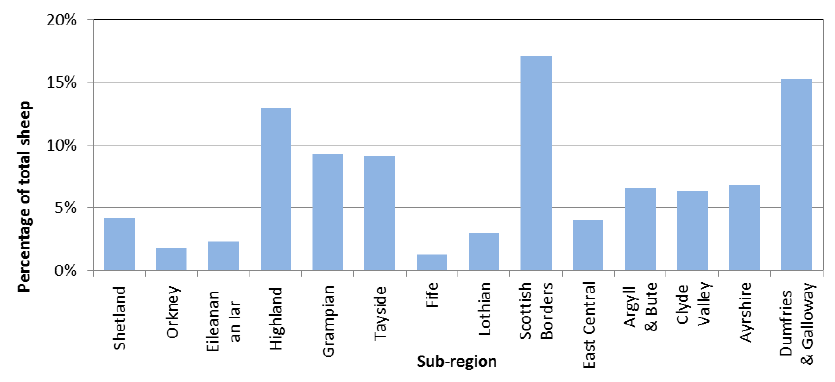
However, once you take into account the size of these sub-regions, Map 11 shows that, while one might associate the large areas of rough grazing in the Highlands with sheep farming, the highest concentration of sheep is to be found south of the central belt, and to a lesser extent on the east coast. The inset map within Map 11 also shows whether the sheep population in a parish is comprised mostly of lambs or older sheep. We can see that parishes with the higher proportions of lambs in June are located largely outwith upland areas, along the east coast and central belt and around coastal areas of the south west.
5.3.2 Size of sheep flocks (Table C14)
There were 2.60 million breeding ewes in Scotland in June 2014, with the majority (1.50 million or 58 per cent) in flock sizes of 500 or more breeding ewes. These larger flock sizes were mostly located in the South East and South West.
Of the 12,714 holdings with breeding ewes, the majority (7,497 or 59 per cent) had flock sizes of less than 100 breeding ewes. However, these holdings only accounted for 234,500 (nine per cent) of breeding ewes in Scotland. Most of these holdings with smaller flock sizes were located in the North West.
Chart 5.15: Breeding sheep, by size group and region, June 2014
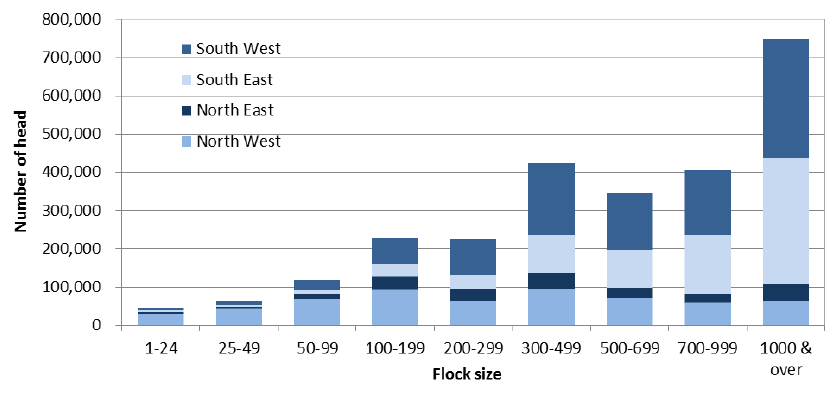
5.3.3 Income from sheep (Table A5)
Sheep account for about seven per cent of income from farming. Since 2004, the value of income from sheep, including store sales but excluding historical related subsidies, has increased by £67 million (35 per cent) to an estimated £215 million in 2014 (see chart 5.1). Between 2005 and 2008 values remained fairly steady, averaging around £140 million. Between 2008 and 2009 there was a 36 per cent increase in value followed by smaller fluctuations in the years after that. 2013 saw an 11 per cent fall, followed by a 15 per cent increase in 2014.
The volume of meat production over the past ten years has been mixed, with increases in one year being reversed the following year. Total production (including from older livestock), shown in chart 5.2, was eight per cent lower in 2014 than in 2004, at 58,000 tonnes, though slightly up on last year’s level of production. Chart 5.16 similarly shows a decline in the production tonnage of finished lambs.
Chart 5.16: Finished lamb production and average price, 2004-2014
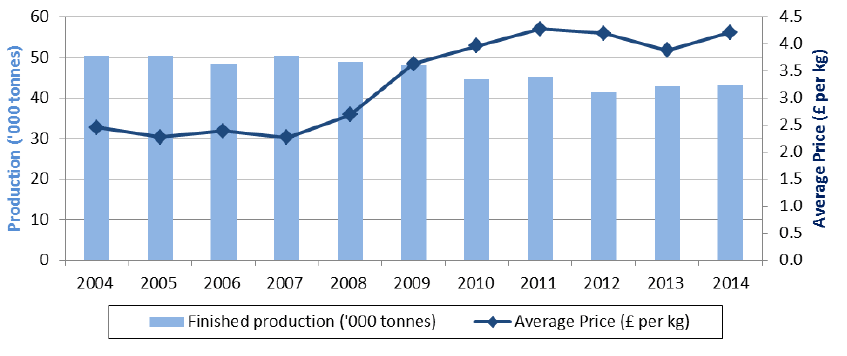
Chart 5.17: Monthly lamb prices in 2009, 2013 and 2014
Prices rose in the first part of 2014, from 387p per kg in January to 468p per kg in June, generally being higher than in 2013. However, when prices then fell they were lower than in 2013, ending the year at 313p per kg.
5.3.4 Income from wool (Table A6)
Chart 5.18: Income from wool, 2004-2014
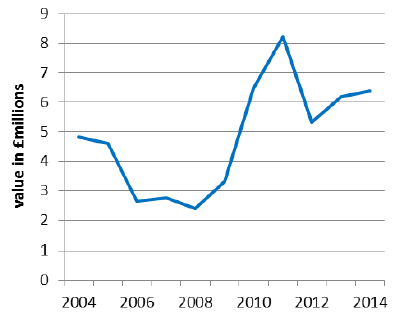
Income from wool only accounted for about £6.4 million in 2014 – income from sheep meat was 33 times greater. The value of wool has however trebled since 2008, due to a considerable increase in price. There was a decrease in value in 2012, but most of this was recovered in 2013 and the value is now 87 per cent up on the 2004 value.
Chart 5.19: Wool production and average price, 2004 to 2014
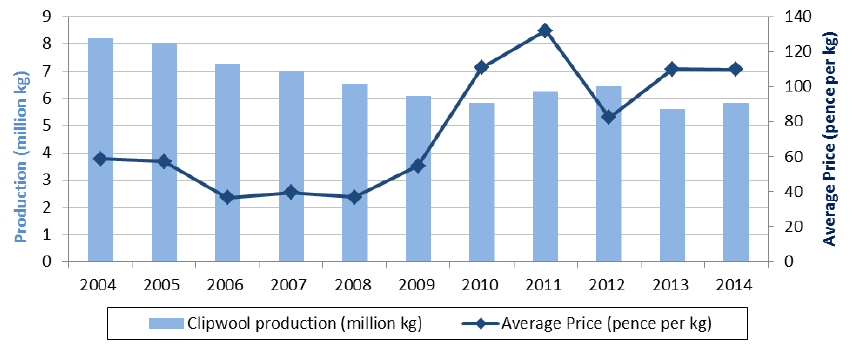
5.3.5 Specialist sheep (LFA) FBI (Table B1)
Accounting for inflation, between 2009-10 and 2013-14, the average FBI of specialist sheep (LFA) farms decreased by around 26 per cent. This decrease was due to a rise in input costs (especially labour and livestock) and a fall in livestock output value.
In the last year both input costs and output value for specialist sheep (LFA) farms have increased, resulting in an overall increase in profits for 2013-14. The average value of grants and subsidies remained largely unchanged to leave the FBI value of specialist sheep (LFA) farms at £24,000. The total average outputs, (including income from diversification and grants and subsidies) and inputs for specialist sheep (LFA) farms were £99,000 and £75,000 respectively. The largest portion of the input costs were due to other inputs such as machinery and land and buildings costs.
Over the last five years, FBI without subsidies has been below zero. An increase was observed in 2011-12 but income has since decreased. It ranges from -£8,000 in 2009-10 to -£16,000 in 2012-13. In 2013-14 the average FBI without subsidies of specialist sheep (LFA) was -£13,000.
Specialist sheep (LFA) Farms
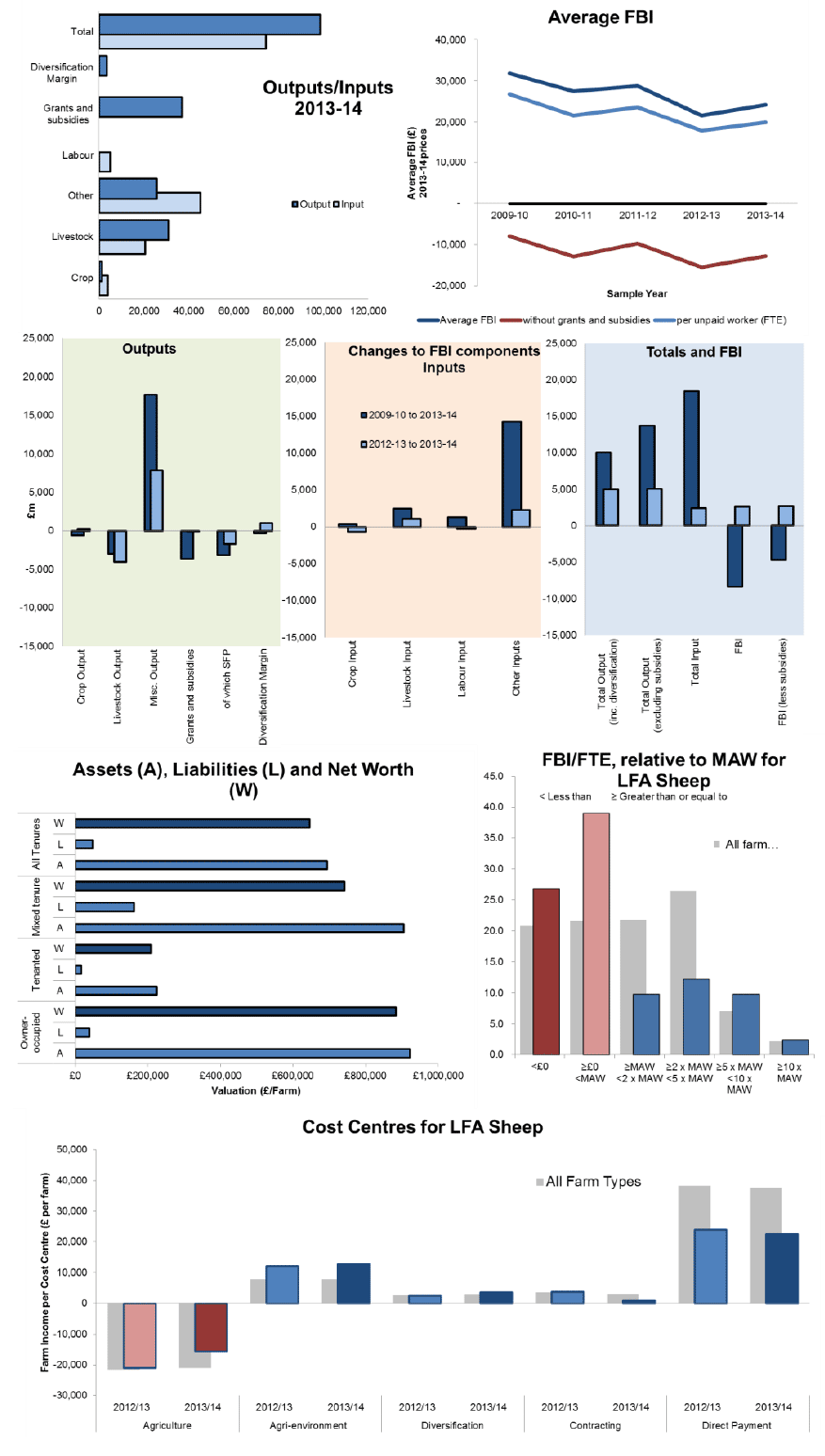
The average FBI/FTE for specialist sheep (LFA) farms of £20,000 is roughly equivalent to an hourly wage for unpaid labour of £10.53, one and a half times the minimum agricultural wage in Scotland. Approximately a quarter of farms (24 per cent) generated an FBI/FTE equivalent to at least twice the minimum agricultural wage per hour of unpaid labour. At the top end, ten per cent generated between five and ten times the minimum agricultural wage, that is, between £33.40 and £68.90 per hour of unpaid labour and two per cent generated more. In contrast, around two thirds of specialist sheep farms (66 per cent) generated incomes equivalent to less than the minimum agricultural wage.
Cost centre analysis for specialist sheep (LFA) farms show an overall increase, over the last year, improvements in income from agricultural and agri-environmental activities as well as diversification over the last year, with a decrease observed for contracting activities and subsidies.
The average net worth of specialist sheep (LFA) farms of all tenures was £645,000; from £209,000 for tenanted farms, to £742,000 for mixed tenure farms and £884,000 for owner occupied farms. The average debt ratio (liabilities: assets) was seven per cent overall but ranged between four per cent for owner-occupied and tenanted farms and 18 per cent for mixed tenure farms.
5.3.6 Sheep enterprises (Table B12)
Overall average gross margins for sheep enterprises ranged from £6 per head for extensive/hardhill production to £36 per head for crossbred ewe production.
Where sample sizes were sufficient to allow comparisons between high and low performers, we can see that low performing sheep enterprises generated considerably lower margins. All low performing sheep enterprises made an average loss, ranging from ‑£8 per head for store lamb finishing enterprises (long keep) to −£42 per head for lowland sheep, whereas high performing enterprises achieved gross margins between £29 per head and £71 per head respectively.
High performing enterprises produced margins around two to three times that of the overall average for each enterprise type. The highest margins were achieved for high performing lowland (non-LFA) and store lamb production enterprises at £71 per head and £65 per head respectively.
For sheep enterprises, differences in gross margins between high and low performers are due to lower variable costs, value added to stocks, and higher sales prices per head which is expected to reflect generally higher quality outputs between the performance groups.
All sheep and lamb enterprises experienced a reduction in their overall average gross margin per head since 2012-13, down, on average, by around 27 per cent. This reduction in margins was caused largely by decreases in the value of sheep between opening and closing valuations, except for finished/store lamb production (where valuations increased but were offset by greater increases in variable costs than in sales prices) and for store Lamb finishing (long keep) where lower margins were caused by a decrease in sales price.
Sheep: Enterprise Gross Margin Measures
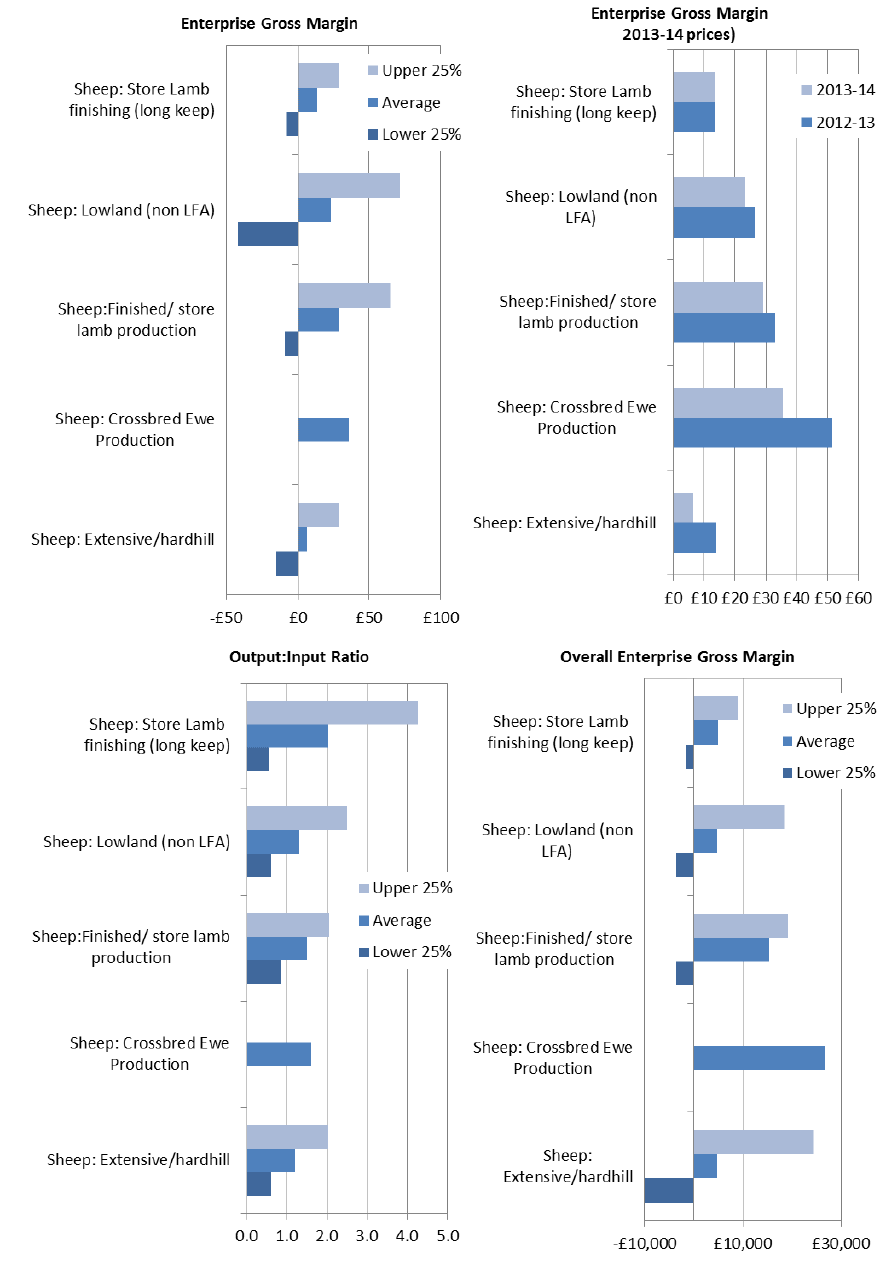
Taking account of the size of enterprises, crossbred ewe production (£27,000) and store lamb production (£15,000) achieved the highest average overall gross margins. Extensive/hardhill, lowland and long keep store lamb finishing enterprises (£5,000) achieved the lowest average overall gross margins. All sheep enterprises saw decreased overall margins compared to 2012-13, with extensive/hardhill declining the most (down 56 per cent).
In contrast to gross margin results, the group average output: input ratios (the return achieved per £1 spent) ranged from 1.2 for extensive/hardhill enterprises to 2.0 for long keep store lamb finishing (the only enterprise group to see an increase in the average output:input ratio compared to 2012-13.
More detailed results, including sample size information, are available from the agriculture statistics web page, Enterprise Performance Analysis[13].
5.3.7 Other cattle & sheep (LFA) FBI (Table B1)
The other cattle & sheep (LFA) category includes all cattle & sheep (LFA) holdings other than those in specialist cattle (LFA) and specialist sheep (LFA).
Accounting for inflation, between 2009-10 and 2013-14 the average FBI of other cattle & sheep (LFA) farms decreased by around 43 per cent. This decrease was due to a rise in input costs, especially labour and livestock and a fall in the value of subsidies and reduced margins from diversification.
In the last year input costs for other cattle & sheep (LFA) farms have slightly increased, while the output value had a greater increase. This combined with an average increase in the value of grants and subsidies (up £2,000) produced a FBI value of other cattle & sheep (LFA) farms at £26,000. The total average outputs, (including income from diversification and grants and subsidies) and inputs for other cattle & sheep (LFA) farms were £172,000 and £146,000 respectively. The largest portion of the input costs was due to feed and other inputs such as machinery, land and buildings.
Over the last five years, FBI without subsidies has been below zero and declining. It ranges from -£19,000 in 2009-10 to -£36,000 in 2012-13. In 2013-14 the average FBI without subsidies of other cattle & sheep (LFA) was -£34,000.
The average FBI/FTE for other cattle & sheep (LFA) of £16,000 is roughly equivalent to an hourly wage for unpaid labour of £8.38, almost equivalent to one and a half times the minimum agricultural wage in Scotland. Approximately a third of farms (32 per cent) generated an FBI/FTE equivalent to at least twice the minimum agricultural wage per hour of unpaid labour. At the top end, two per cent generated more than five times the minimum agricultural wage, that is, greater than £33.40 per hour of unpaid labour. In contrast, nearly half of other cattle & sheep (LFA) farms (47 per cent) generated incomes equivalent to less than the minimum agricultural wage.
Trends in cost centres for other cattle & sheep (LFA) farms show an overall increase in income as part of diversification and contracting compared to 2012-13, with
Other Cattle & Sheep Farms (LFA)
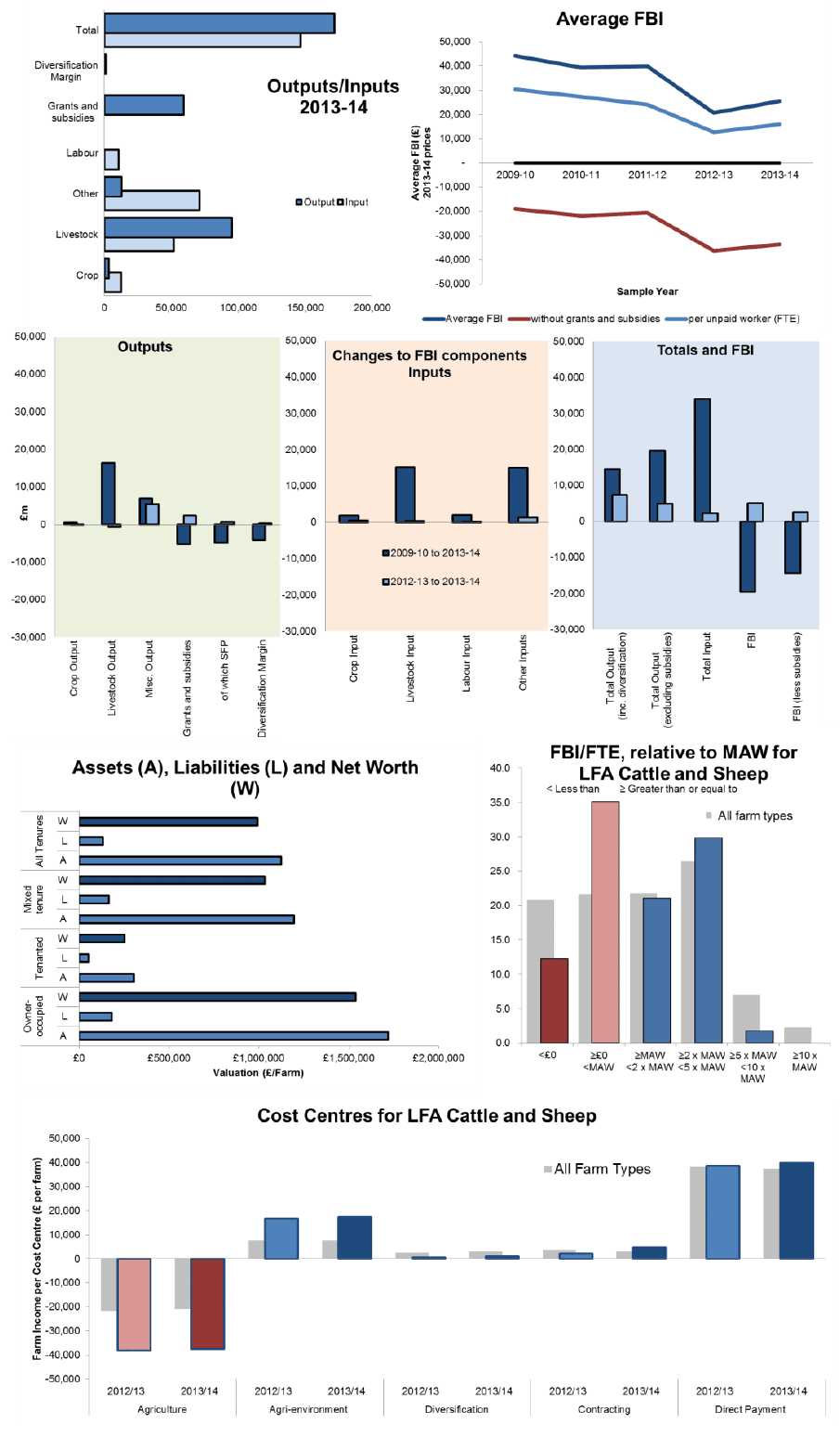
income from agricultural and environmental activities and subsidies remaining largely unchanged.
The average net worth of other cattle & sheep (LFA) farms of all tenures was £992,000; from £252,000 for tenanted farms, to £1,033,000 for mixed tenure farms, and to £1,538,000 for owner occupied farms. The average debt ratio (liabilities: assets) was 12 per cent for all tenures of other cattle & sheep (LFA) farms but ranged between 11 per cent for owner-occupied and 18 per cent for tenanted farms.
5.3.8 Lowland cattle & sheep FBI (Table B1)
Accounting for inflation, between 2009-10 and 2013-14 the average FBI of lowland cattle & sheep farms decreased by around 41 per cent. This was due to an increase in the input costs for livestock and machinery, land and buildings.
In the last year both input costs and output values for lowland cattle & sheep farms have increased, resulting in an overall increase in FBI value for 2013-14. The average value of grants and subsidies has remained unchanged to leave the FBI value of lowland cattle & sheep farms at £24,000. The total average outputs, (including income from diversification and grants and subsidies) and inputs for lowland cattle & sheep farms were £181,000 and £157,000 respectively. The largest portion of the input costs was due to feed and other inputs such as machinery, land and buildings.
Over the last five years, FBI without subsidies has been below zero. It has ranged from -£23,000 in 2012-13 to -£6,000 in 2010-11. In 2013-14 the average FBI without subsidies of lowland cattle & sheep farms was -£18,000.
The average FBI/FTE for lowland cattle & sheep farms of £17,000 is roughly equivalent to an hourly wage for unpaid labour of £8.78, below the minimum agricultural wage in Scotland. Approximately a third of farms (30 per cent) generated an FBI/FTE equivalent to at least twice the minimum agricultural wage per hour of unpaid labour. At the top end, three per cent generated more than ten times the minimum agricultural wage, that is, greater than £68.90 per hour of unpaid labour. In contrast, nearly half of lowland cattle & sheep farms (48 per cent) generated incomes equivalent to less than the minimum agricultural wage.
Trends in cost centres for lowland cattle & sheep farms show an overall increase in income as part of agricultural compared to 2012-13, with diversification, contacting, subsidies and environmental activities remaining largely unchanged.
The average net worth of lowland cattle & sheep farms of all tenures was £1,119,000, from £432,000 for tenanted farms, to £1,125,000 for mixed tenure farms, and to £1,251,000 for owner occupied farms. The average debt ratio (liabilities: assets) was ten per cent for all tenures of lowland cattle and sheep farms but ranged between eight per cent for owner-occupied and 14 per cent for mixed farms.
Lowland Cattle & Sheep Farms
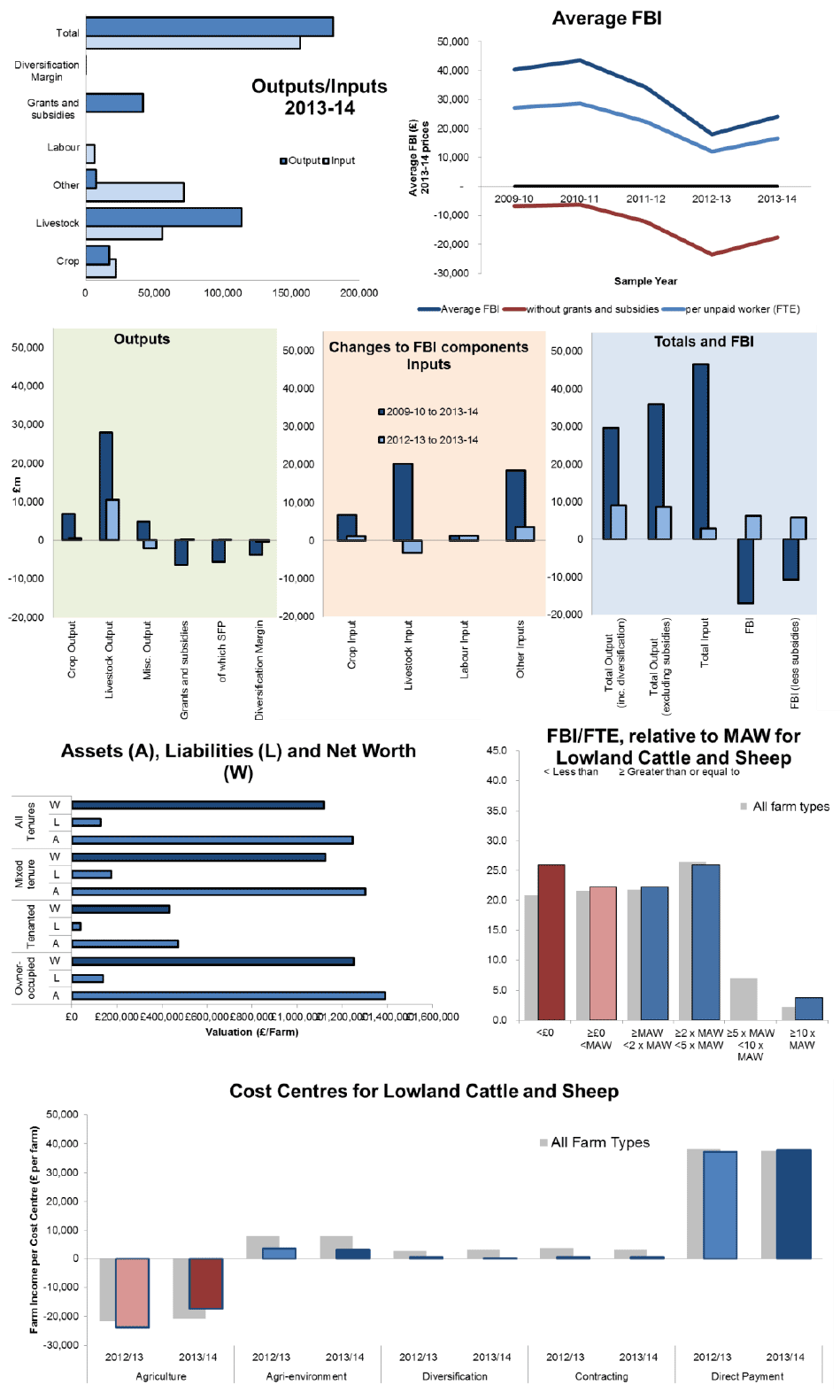
Contact
Email: Agricultural Statistics
There is a problem
Thanks for your feedback
